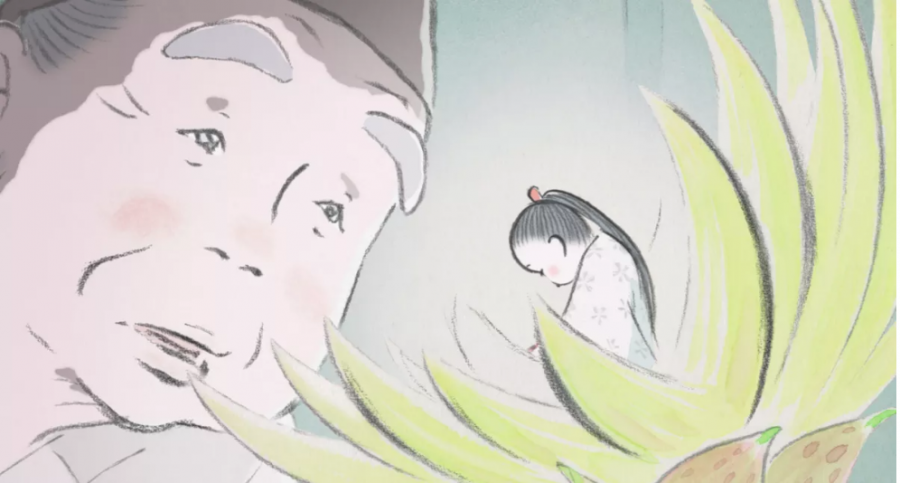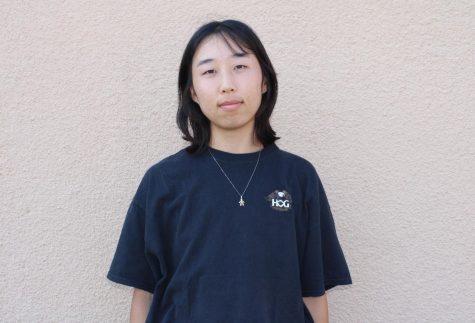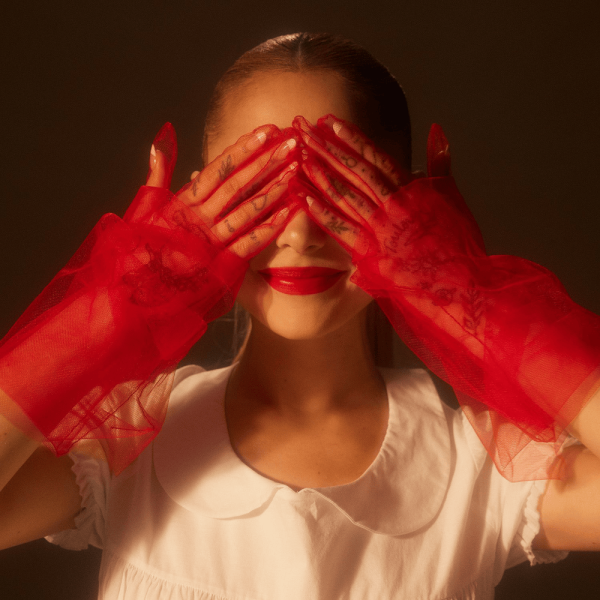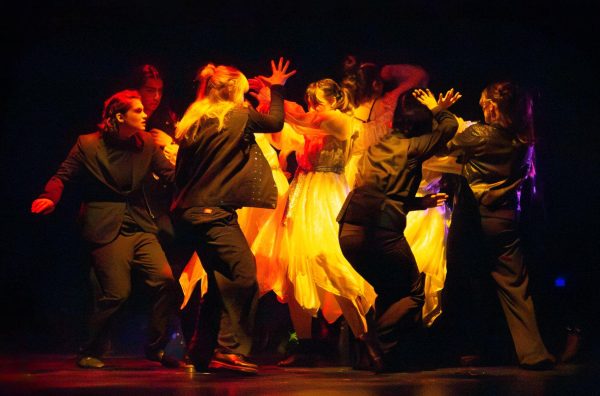Retelling a Japanese Folktale: The Tale of Princess Kaguya
The bamboo cutter discovers Princess Kaguya in a bamboo shoot in The Tale of Princess of Kaguya (The Verge).
April 13, 2021
Eight years ago, Studio Ghibli released yet another animated movie that would shake the world with its beautiful and unique storytelling. Directed by Isao Takahata, the film retells an old Japanese legend, The Tale of the Bamboo Cutter, with colorful imagery and lively animations that bring the story to life. Described as “quiet but powerful” by Vulture, The Tale of Princess Kaguya contains a deeper meaning beyond the serenity that the movie portrays. I recommend watching Princess Kaguya before reading on as I will include spoilers throughout this review; it also helps if you have your own interpretations of certain scenes so that you can compare them to mine as you continue reading my thoughts and opinions in this article.
We are first introduced to the bamboo cutter, who is working in a bamboo forest when he discovers a bamboo shoot that opens and reveals a little girl. Believing that she is a gift sent from heaven, he refers to her as “Princess” and immediately returns home to his wife, carrying her safely in his cupped hands. The small princess then morphs into a human baby, and the old couple becomes determined to raise her with love and care as if she were their own blood-born child.
As we watch the princess’s rapid development through the seasons, we can see that their lifestyle is one of simplicity and modesty. The couple’s house is bare and open to the wonderful countryside, where frogs make frequent visits into their humble home and neighboring boys run over to play with the toddler. The princess is a perfect depiction of a joyful baby who is teeming with life; she has a wide range of emotions, her face shifting from a wrinkly pout to an eye-squinting smile within a few minutes. As she matures and grows up in this “simple” country village, it’s obvious that she is content and happy with her life. The old couple does their best to provide for her and love her as any caring parent would, but this love soon becomes misguided when the bamboo cutter begins to come across piles of gold and rich fabrics that appear whenever he chops down a bamboo stalk. Presuming that they are gifts from heaven to provide for the princess, the father decides to head to the capital to build a grandiose house for the little girl. Without warning, the princess is forced to follow her parents and leave her childhood behind, unable to say goodbye to her friends.
The tale immediately begins its downfall as we see the princess’s silent reluctance to leave her home. As the young girl is forced to transform into a noblewoman in her new Japanese mansion, we are able to see a new perspective on what it means to be a princess. Contrary to Disney films such as Snow White and the Seven Dwarfs, The Tale of Princess Kaguya focuses on the struggles that come with high social status and takes on a mature look at life. Through this animated film, Isao Takahata asks the audience what it really means to live, and what it is that we really live for. He comments on the stupidity and irrelevance of social hierarchy as he shows us the princess’s developing unhappiness while living in the capital; ultimately, he conveys that wealth doesn’t truly give us happiness through Kaguya’s experiences and pains. Cosmetically, she is forced to have her eyebrows plucked and her teeth blackened to fit the beauty standards placed on all noblewomen in Japan during ancient times. She is told to never show her emotions, and that she should never scream, cry, or laugh as women are expected to be docile and obedient. However, in face of all this, the princess remains strong, compassionate, and vibrant. Although she eventually submits to having her face “beautified,” she never loses her passion and liveliness as she continues to stand up for herself and refuses to be “owned by anyone.” This becomes crucial when men come flocking to the family’s mansion as rumors begin to spread of Kaguya’s legendary beauty.
I believe that the princess’s perseverance and independence are what spoke to me the most. She never submitted to anyone and wanted to live as she pleased without a man or even her own parents providing her financial stability. In one scene, Kaguya’s teacher insists that the young girl “must marry a suitable gentleman as soon as possible. That is happiness itself”; she questions her, asking her, “Why would you hesitate? With any of those men, your happiness is assured.” This dialogue speaks volumes on how we constantly associate wealth with one’s well-being. The fact that Kaguya never sees her luxurious life as a ticket to happiness is what makes her such a great model for all audiences to look up to.
Throughout this movie, Takahata also comments on parenting and how a parent’s affection for their child can take a wrong turn, eventually leading to their misery. It’s clear to see that the bamboo cutter adores the young girl, so much that he never gives her a proper name and always refers to her as “Princess.” However, it’s apparent that his way of showing love and caring for Kaguya is not what any parent should follow. The bamboo cutter clearly feels that wealthiness and financial security is what will provide comfort and happiness for the princess. The fact that he asks a nobleman to name his own child (which is how the princess finally receives the name “Kaguya”) demonstrates how much he looks up to and respects the wealthy. He also persistently pushes her to fit in with the nobles and insists that she must marry a rich man despite the fact that she does not know any of the men who seek to court her. As we later see, this misguided love is what drives Princess Kaguya to desperately resort to asking the moon for help.
Being a frequent watcher of Studio Ghibli’s films, the first thing that grabbed my attention while watching this movie was the art style. The rough charcoal-like lines seem to replicate the black brushstrokes of ancient Japanese paintings, giving the movie a traditional and natural feel that looks nothing like the modern animation styles we see today. Some think that the thick lines make scenes appear messy and unrefined, but I feel that there is so much more emotion conveyed through the various thick and thin strokes of charcoal compared to the monotonous, thin lines of regular animations. At times of peace and regular conversation in the film, the drawings are smooth and elegant, but when tension arises and Kaguya experiences intense sadness or rage, the lines soon become broad and rushed, clearly expressing the emotions that the princess feels onto paper. It truly adds so much depth to the film and is not something that should be overlooked.
I showed sophomore Thomas Fukuda a small clip of the movie, and he simply stated that he was “at a loss for words.” The art style was unlike anything he had seen before in Ghibli animations, and he felt that it “added to the character of the film.” I have to agree; The Tale of Princess Kaguya is indeed a unique movie that paves its own path and refuses to follow the footsteps of its predecessors.
The Tale of Princess Kaguya presents a strong female lead, a tale full of emotion and life, and a distinctive art style that beautifully conveys emotion through every stroke. Taking on a mature perspective of life, this film isn’t only for children; it’s something that everyone should stop to take a look at, no matter their age. As the movie finally comes to a harrowing close, a question lingers for us to answer as the credits begin to roll over the black screen: what does it truly mean to live?














